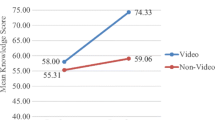Abstract
Intrathecal chemotherapy procedures are stressful to patients and caregivers, especially the first time. Providing the patient and caregiver with sufficient information to address their concerns before the scheduled procedure is necessary. This study aims to determine whether the use of video instructions could enhance learning outcomes and decrease anxiety levels in patients’ caregivers. A prospective trial was conducted in pediatric hematology for 1 year. Thirty-seven respondents were randomly assigned to two groups wherein one group was given conventional educational leaflets and verbal instructions, while the other group received the same information through an educational video presentation before the intrathecal chemotherapy procedure. Knowledge enhancement in the two groups was evaluated using the summative assessment method and measured by a 10-point Likert scale. The validated Arabic version of the Beck Anxiety Inventory (BAI) scale was used to assess anxiety levels. The anxiety level (12.31 ± 8.84) in the video presentation group was significantly higher than that in the conventional group (6.16 ± 5.91). Similarly, the overall Beck scale score revealed that palpitation, frightening, lightheadedness, and hot/cold sweat levels were decreased in the video presentation group. Additionally, a significant difference in knowledge enhancement was noted between the two groups, as knowledge enhancement in the video presentation group (7.61 ± 1.88) was better than that in the conventional group (6.00 ± 1.00). This produced a domino effect on the anxiety level scores of both groups. An educational video presentation before the intrathecal chemotherapy procedure is effective since both visual and auditory senses are involved. This could be considered a good source of an interventional approach before a therapeutic procedure.
Similar content being viewed by others
References
Forchuk C (1994) The orientation phase of the nurse-client relationship: testing Peplau's theory. J Adv Nurs 20(3):532–537. https://doi.org/10.1111/j.1365-2648.1994.tb02392.x
Edition, F., & American Psychiatric Association (2013) Diagnostic and statistical manual of mental disorders. American Psychiatric Publishing, Arlington
Gullatte MM (2007) Clinical guide to antineoplastic therapy: a chemotherapy handbook, 3rd edn. Pittsburgh, Oncology Nursing Society
Salzwedel C, Petersen C, Blanc I, Koch U, Goetz AE, Schuster M (2008) The effect of detailed, video-assisted anesthesia risk education on patient anxiety and the duration of the preanesthetic interview: a randomized controlled trial. Anesth Analg 106(1):202–209. https://doi.org/10.1213/01.ane.0000287665.96156.72
Stark DPH, House A (2000) Anxiety in cancer patients. Br J Cancer 83(10):1261–1267
Miller KM, Wysocki T, Cassady JF, Cancel D, Izenberg N (1999) Validation of measures of parents' preoperative anxiety and anesthesia knowledge. Anesth Analg 88(2):251–257. https://doi.org/10.1213/00000539-199902000-00005
Redd WH, Montgomery GH, DuHamel KN (2001) Behavioral intervention for cancer treatment side effects. J Natl Cancer Inst 93(11):810–823. https://doi.org/10.1093/jnci/93.11.810
Lee A, Gin T (2005) Educating patients about anaesthesia: effect of various modes on patients' knowledge, anxiety and satisfaction. Curr Opin Anesthesiol 18(2):205–208. https://doi.org/10.1097/01.aco.0000162842.09710.d5
Hahn CA, Fish LJ, Dunn RH, Halperin EC (2005) Prospective trial of a video educational tool for radiation oncology patients. Am J Clin Oncol 28(6):609–612. https://doi.org/10.1097/01.coc.0000182417.94669.a0
Hoerger M, Epstein RM, Winters PC, Fiscella K, Duberstein PR, Gramling R, Butow PN, Mohile SG, Kaesberg PR, Tang W, Plumb S, Walczak A, Back AL, Tancredi D, Venuti A, Cipri C, Escalera G, Ferro C, Gaudion D, Hoh B, Leatherwood B, Lewis L, Robinson M, Sullivan P, Kravitz RL (2013) Values and options in cancer care (VOICE): study design and rationale for a patient-centered communication and decision-making intervention for physicians, patients with advanced cancer, and their caregivers. BMC Cancer 13(1):188. https://doi.org/10.1186/1471-2407-13-188
Cassady JF, Wysocki TT, Miller KM, Cancel DD, Izenberg N (1999) Use of a preanesthetic video for facilitation of parental education and anxiolysis before pediatric ambulatory surgery. Anesth Analg 88(2):246–250. https://doi.org/10.1213/00000539-199902000-00004
Lewis D (1999) Computer-based approaches to patient education: a review of the literature. J Am Med Inform Assoc 6(4):272–282. https://doi.org/10.1136/jamia.1999.0060272
Fydrich T, Dowdall D, Chambless DL (1992) Reliability and validity of the Beck Anxiety Inventory. J Anxiety Disord 6(1):55–61
Sorg BA, Whitney P (1992) The effect of trait anxiety and situational stress on working memory capacity. J Res Pers 26(3):235–241. https://doi.org/10.1016/0092-6566(92)90041-2
Kerrigan DD, Thevasagayam RS, Woods TO et al (1993) Who’s afraid of informed consent? BMJ 306(6873):298–300. https://doi.org/10.1136/bmj.306.6873.298
Snyder-Ramos SA, Seintsch H, Böttiger BW, Motsch J, Martin E, Bauer M (2005) Patient satisfaction and information gain after the preanesthetic visit: a comparison of face-to-face interview, brochure, and video. Anesth Analg 100(6):1753–1758. https://doi.org/10.1213/01.ANE.0000153010.49776.E5
Zvara DA, Mathes DD, Brooker RF, McKinley AC (1996) Video as a patient teaching tool: does it add to the preoperative anesthetic visit? Anesth Analg 82(5):1065–1068. https://doi.org/10.1097/00000539-199605000-00033
Luck A, Pearson S, Maddem G, Hewett P (1999) Effects of video information on precolonoscopy anxiety and knowledge: a randomised trial. Lancet 354(9195):2032–2035. https://doi.org/10.1016/S0140-6736(98)10495-6
Synnot A, Ryan R, Prictor M, Fetherstonhaugh D, Parker B (2014) Audio-visual presentation of information for informed consent for participation in clinical trials. Cochrane Database Syst Rev 5
Cakmak M, Kose I, Zinzircioglu C, Karaman Y, Tekgul ZT, Pektas S, Balik Y, Gonullu M, Bozkurt PS (2018) Effect of video-based education on anxiety and satisfaction of patients undergoing spinal anesthesia. Rev Bras Anestesiol 68(3):274–279
DiMatteo MR (2004) Social support and patient adherence to medical treatment: a meta-analysis. Health Psychol 23(2):207–218
Uzark K, Klos D, Davis W, Rosenthal A (1982) Use of videotape in the preparation of children for cardiac catheterization. Pediatr Cardiol 3(4):287–291. https://doi.org/10.1007/BF02427
Author information
Authors and Affiliations
Corresponding author
Ethics declarations
Conflict of Interest
The authors declare that they have no conflict of interest.
Additional information
Publisher’s Note
Springer Nature remains neutral with regard to jurisdictional claims in published maps and institutional affiliations.
Rights and permissions
About this article
Cite this article
Bany Hamdan, A., Ballourah, W., Elghazaly, A. et al. The Effect of Video-Assisted Education Prior Intrathecal Chemotherapy on Anxiety and Knowledge Enhancement. J Canc Educ 37, 65–70 (2022). https://doi.org/10.1007/s13187-020-01787-1
Published:
Issue Date:
DOI: https://doi.org/10.1007/s13187-020-01787-1




